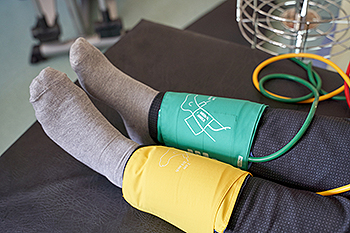
Peripheral arterial disease, or PAD, is a condition that affects blood flow to the legs and feet due to narrowed or blocked arteries. Reduced circulation can lead to pain, numbness, cold feet, or slow-healing wounds, especially during walking or activity. Some people may feel cramping in the calves or feet that improves with rest. PAD is more common in older adults and those with diabetes, high blood pressure, or a history of smoking. It may also cause changes in skin color or hair loss on the legs. Left untreated, PAD increases the risk of serious complications such as foot ulcers or infections. Lifestyle changes, medications, and sometimes surgical options are used to improve circulation. If you notice pain in your feet during activity or other signs of poor circulation, it is suggested that you see a podiatrist who can assess your symptoms and recommend appropriate care.
Peripheral artery disease can pose a serious risk to your health. It can increase the risk of stroke and heart attack. If you have symptoms of peripheral artery disease, consult with Priyanka Mude, DPM from North Canton Podiatry. Our doctor will assess your condition and provide you with quality foot and ankle treatment.
Peripheral artery disease (PAD) is when arteries are constricted due to plaque (fatty deposits) build-up. This results in less blood flow to the legs and other extremities. The main cause of PAD is atherosclerosis, in which plaque builds up in the arteries.
Symptoms
Symptoms of PAD include:
- Claudication (leg pain from walking)
- Numbness in legs
- Decrease in growth of leg hair and toenails
- Paleness of the skin
- Erectile dysfunction
- Sores and wounds on legs and feet that won’t heal
- Coldness in one leg
It is important to note that a majority of individuals never show any symptoms of PAD.
Diagnosis
While PAD occurs in the legs and arteries, Podiatrists can diagnose PAD. Podiatrists utilize a test called an ankle-brachial index (ABI). An ABI test compares blood pressure in your arm to you ankle to see if any abnormality occurs. Ultrasound and imaging devices may also be used.
Treatment
Fortunately, lifestyle changes such as maintaining a healthy diet, exercising, managing cholesterol and blood sugar levels, and quitting smoking, can all treat PAD. Medications that prevent clots from occurring can be prescribed. Finally, in some cases, surgery may be recommended.
If you have any questions, please feel free to contact our office located in North Canton, Ohio . We offer the newest diagnostic and treatment technologies for all your foot care needs.
